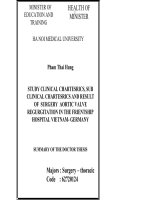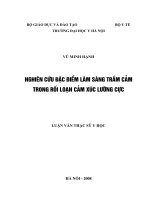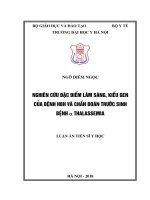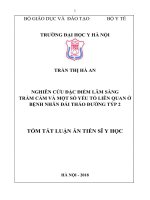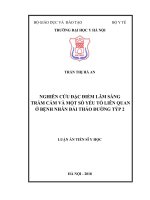TTLA tieng anh nghiên cứu đặc điểm lâm sàng trầm cảm ở bệnh nhân động kinh cơn co cứng co giật và kết quả điều trị trầm cảm bằng fluoxetin
Bạn đang xem bản rút gọn của tài liệu. Xem và tải ngay bản đầy đủ của tài liệu tại đây (440.99 KB, 29 trang )
MINISTRY OF EDUCATION AND TRAINING - MINISTRY OF DEFENSE
MILITARY MEDICAL UNIVERSITY
DAM DUC THANG
RESEARCH ON CLINICAL FEATURES OF DEPRESSIVE
DISORDER IN PATIENTS WITH GENERALIZED TONIC –
CLONIC SEIZURES AND RESULTS OF TREATMENT
FOR DEPRESSIVE DISORDER WITH FLUOXETINE
Specialism: Neuroscience
Code: 9720159
SUMMARY OF MEDICAL DOCTORAL THESIS
HANOI – 2018
THE WORK HAS BEEN SUCCESSFULLY COMPLETED AT
MILITARY MEDICAL UNIVERSITY
Science Supervisors:
1. Associate.Prof. PhD. BUI QUANG HUY
2. Associate.Prof. PhD. NGO NGOC TAN
Opponent 1: Prof. PhD. Nguyen Van Chuong
Opponent 2: Associate.Prof. PhD. Tran Van Cuong
Opponent 3: Associate.Prof. PhD. Nguyen Hoang Ngoc
The thesis will be protected before the doctoral thesis review
Board in Military Medical University - Ministry of Defense
By the hour,day
month
2018
The thesis can be found at the library:
1. Military Medical University library- Ministry of Defense
2. National library of Vietnam
1
BACKGROUND
1. Urgency of the project
Epilepsy is a syndrome of the brain due to many causes, the rate
of epilepsy accounts for 0.5 -1% of the world population. In Vietnam,
there are 5-8 people with epilepsy per 1000 people. Generalized
seizures make up a high proportion among epilepsy patients, in which
generalized tonic-clonic seizures is the most common.
Depressive disorder in patients with epilepsy accounts for about
20-40%. However, clinical symptoms of depression are often atypical
and therefore difficult to diagnose and evaluate.
The frequency of seizures, some antiepileptic drugs, community
stigma, etc., are associated with depressive disorder in patients with
epilepsy.
The concentration of Serotonin in plasma is considered be related
to depressive disorder and it is often significantly reduced compared
with healthy people.
Recent research has shown that selective Serotonin reuptake
inhibitors are the first choice for the treatment of depressive disorder in
patients with epilepsy. In particular, Fluoxetine is approved by the Food
and Drug Administration (the United States) for the treatment of
depressive disorder.
In Vietnam, there have been some sporadic scientific reports about
depressive disorder in patients with epilepsy. Depressive disorder in
patients with epilepsy has not been carefully investigated and studied
yet.
2. Purposes of the thesis
- Study clinical characteristics of depressive disorder in patients
with generalized tonic - clonic seizures patients.
2
- Evaluate of plasma Serotonin levels and risk factors associated with
depressive disorder in patients with generalized tonic - clonic seizures.
- Comment on the results of treatment for depressive disorder
inthe patients suffering from generalized tonic - clonic seizures with
Fluoxetine combined with antiepileptic drugs.
3. Practical significance and new contributions of the thesis
- The thesis is the first systematic study on clinical features,
plasma Serotonin levels and associated risk factors, especially on the
treatment of depressive disorder in patients with generalized tonic clonic seizures (GTCs) with Fluoxetine combined with antiepileptic
drugs (AEDs) applied in Vietnam.
- The study found that moderate depressive disorder in patients with
GTCs had the highest rate of 71.57%.The seizures are more frequent in
the patients with GTCs associated with depression. 38.24% of patients
used more than 2 AEDs, in which those used both Phenobarbital (PB)
and Phenytoin (PTH) at the same time accounted for 74.36%. Average
dosage of Fluoxetin 20.61 ± 3.45 mg per day was effective for treating.
- The research opens a new direction for the selection of
antidepressants, especially Fluoxetine combined with AEDs for
treatment of depressive in epilepsy.
4. Structure of the thesis
The thesis is presented in 164 pages, 44 tables of data, 11 charts and
2 illustrations. The content includes: background 2pages; Chapter 1:
Overview 38pages; Chapter 2: Subject and Methodology 20
pages; Chapter 3: Study results 36 pages; Chapter 4: Discussion
45pages and 2 Pagesof Conclusion;1 page of proposal; List of research
works of thesis:1 page; 19 pages of references (21 Vietnamese
documents and 145 foreign documents).
3
CHAPTER 1: OVERVIEW
1.1. Generalized tonic - clonic seizures
The GTCs is a typical generalized seizure caused by the sudden
electrostatic discharge that spreads both hemispheres in clinical
manifestations from the first episode. Clinical manifestations are
typically characterized by 3 successive phases: tonique, clonique and
resolutive, lasting about 40 to 70 seconds or up to 90 seconds.
The ictal Electroencephalogram (EEG) is often obscured by muscle
artifact. During the tonic phase, fast, rhythmic, low - amplitude spike
are seen in all leads, wich evolve to a spike- wave or polyspike- andwave pattern during the clonic phase. Postically, there is diffuse
suppression of electrical activity, followed by generalized slowing.
The interictal EEG is often seen with cerebral arrhythmia,
alternating with slow waves (delta, theta) high amplitude or spike,
can be seen as ictal paroxysmal series.
1.2. Depressive disorder in patients with epilepsy
Currently, pathogenic mechanisms of depressive disorder in
patients with epilepsy have not been completely elucidated.
Structural abnormalities, monoamine pathways, cerebral glucose
metabolism, the hypothalamic-pituitary-adrenal (HPA) axis, and
interleukin-1b all play a role in the common pathogenesis of these
conditions.
Clinical features of depressive disorder in patients with epilepsy
are often atypical. Depressive symptoms in patients with epilepsy can
be classified in 3 categories: major depressive disorder, atypical
depression or dysthymia, or a dysthymic-like disorder with
4
intermittent symptoms that can be milder than those of major
depression.
Serotonin levels in plasma and cerebrospinal fluid of depressed
patients are often lower than normal.
There are many risk factors associated with depressive disorder in
patients with epilepsy such as some AEDs, frequency of seizure,
stigma, social psychology etc.
1.3. Treatments for depressive disorder in patients with epilepsy
Antidepressants, selective inhibition of serotonin reuptake
(SSRIs) are the first choice of treatment for depressive disorder in
patients with epilepsy.
Fluoxetine is one of the SSRI group of antidepressants approved
by FDA for the treatment of depressive disorder in patients with
epilepsy. Fluoxetine doses start with 10 mg per day, the maximum
dose is 80mg per day. Fluoxetine suppresses cytochrome P-450
enzymes which may increase the concentration of AEDs in the
cerebrospinal fluid and plasma, thereby increasing the anticonvulsant
capacity of AEDs.
The second option is SNRI antidepressants including venlafaxine,
mirtazapine and duloxetine.
In developing countries tricyclic antidepressants are also selected,
but they are less tolerant and highly toxic in overdose.
In addition, combining psychotherapy, vagus nerve stimulation
and medicine application is more effective in treatment than using
antidepressants only.
5
CHAPTER 2: SUBJECTS AND METHODOLOGY
2.1. Subjects
2.1.1. Characteristics of the subjects
A study of 102 GTCs patients diagnosed with depression. Patients
were treated at the Hai Phong Psychiatric Hospital between April
2013 and October 2015.
2.1.2. Selection criteria
- Diagnosis criteria for GTCsare based on ILAE (1981) and ICD-10
(1992): standard G40.30
- Diagnosisfor organic depressive disorder isaccording to the ICD-10
(1992): standard F06.32.
2.2. Study method
2.2.1. Study design
- Prospective and cross-sectional study.
-Clinical trial with treatment.
2.2.2. Study sample size
In this study we applied the "scaled estimate in a population"
according to the formula:
p = 0.427 (in the study of Lopez-Gomez M. (2005), Δ =0.1. We
calculated n= 94 patients (minimum size). In our study, we chose 102
GTCs patients.
2.2.3. Clinical assessment tool and results of treatment for
depressive disorder in patients with GTCs.
The clinical assessment and results oftreatment for depressive
inpatients with GTCsare based on the following materials:
- Detailed medical records, meeting the research objectives.
6
- ILAE Classification of Epilepsy (1981).
- International Classification of Diseases ICD-10 (1992): section
G40.30 for the diagnosis of GTCs, section F06.32 for the diagnosis
of organic depressive disorder.
- Hamilton Depression Rating Scale (HAM-D)
- Quantification of Serotonin concentrations in plasma.
2.2.4. Clinical features of depressive disorder in patients with GTCs
- Clinical evaluation of depressive disorder.
- Clinical evaluation ofmental disorders in the research group.
- Some laboratory tests supporting the differential diagnosis.
2.2.5. Evaluation of Serotonin levels in plasma and risk factors
related to depressive disorder inpatients with GTCs.
+ Serotonin plasma concentrations at the time of admission (T0)
and after 8 weeks of treatment (T8) 88 patients in the study group.
+ Risk factors include:
- Duration of epilepsy, age at onset of seizure, causes of epilepsy,
frequency of seizure, sex, ect.
- Dosage and duration of using AEDs (alone or combined)
2.2.6. The results of treatment for depressive disorder inpatients
with GTCs by Fluoxetine combination with AEDs.
-The dosage of Fluoxetine (Oxeflu).
- The dosage of AEDs.
- Evaluation of clinical course and Hamilton scale.
2.3. Data processing method and assessment of research results
The data was processed and analyzed on the Stata 12.0 program
and we used statistical algorithms applied in medicine.
7
CHAPTER 3: RESULTS
3.1. General characteristics of the research subject
Table 3.1. Age of the study subjects
No
Statistics index
Age group (year)
Quantity
Proportion %
1
< 20
5
4.90
2
20 - 29
27
26.47
3
30 - 39
24
23,53
4
40 - 49
22
21.58
5
50 - 59
12
11.76
6
60
12
11.76
102
male; 50.00%
100.00
Total
female;
50.00%
Average age
38.59 ± 14.14 year old
Table 3.1 the youngest is 18 years old and the oldest is 79 years old,
an average age is 38.59 ± 14.14 years old.
Figure 3.1. Gender of study group
Figure 3.1 shows that 51 male patients accounting for 50.00%, there
by male/female ratio = 1.
8
3.2. Clinical characteristics of depressive disorder in patients
with generalized tonic - clonic seizures.
Figure 3.3. Typical symptoms of depression
Figure 3.3 shows that the typical symptoms of depression are 96.08%
of depressed mood, 69.61% of loss of interest and enjoyment, 77.45% of
reduced energy leading to increased fatiguability.
Table 3.6. Common symptoms of depression
Statistics index Quantit Proportio
No
Symptoms
y
n%
1 Reduced concentration and attention
87
85.29
Reduced self-esteem and self2
89
87.25
confidence
3 Ideas of guilt and unworthiness
50
49.02
Bleak and pessimistic views of the
4
97
95.10
future
5 Ideas or acts of self-harm or suicide
37
36.27
6 Disturbed sleep
101
99.02
7 Diminished appetite
80
78.43
Table 3.6 shows that disturbed sleep has the highest rate of 99.02%,
95.10% of bleak and pessimistic views of the future, 87.25% of
reduced self-esteem and self-confidence, 49.02% of ideas of guilt and
unworthiness, 36.27% of ideas or acts of self-harm or suicide.
Table 3.7. Physical symptoms
No
1
2
Statistics index
Symptoms
Burning abdomen
Feeling of nausea
Digestive
system
Feeling of intestinal spasm
Indigestion
Cardio-vascular Palpitation
Body parts
(Q)
(Pr %)
16
3
9
23
17
15.69
2.94
8.82
22.55
16.67
9
system
3
4
Vegetative
nervous
system
Others
Tachycardia
11
Flushing
10
Dizziness
14
Sweating
5
Numbness
8
Other
1
7.84%desire
Reduced sexual
43
20.59%
Menstrual disorders
14
Mild depressive
(n=51)
10.78
9.80
13.73
4.90
7.84
0.98
42.16
27.45
Moderate arereduced
Table 3.7 shows that the most common symptoms
depressive
sexual desire (42.16%), followed by indigestion 22.55%, palpitation
16.67%, dizziness 13.73%.
71.57%
Severe depressive
Figure 3.4. Levels depressive disorder according to ICD - 10
Figure 3.4 shows that moderate depressive disorder is the most
common accounting for 71.57%, severe depressive disorder making
up 20.59% and mild depressive disorder 7.84%.
3.3. Serotonin levels in plasma and risk factors associated with
depressive disorder in patients with GTCs.
3.3.1. Concentration of Serotonin in plasma
Table 3.23. Serotonin plasma concentrations at T0 and T8 (n=88)
10
Time
Concentratio
Medium
Min – Max
(ng/ml)
(ng/ml)
p
Average duration time 20.89 ± 13.06 years
n
First 17.760%
test (T0)
21.570%
24.61 - 139.74
42.30 ± 24.46
19.160%
16.670%
2nd test (T8) 9.800%
79.39 ± 67.87
25.68 – 407.67
11.760%
8.820%
< 0.01
Table 3.23 shows that Serotonin levels at T0 were 42.30 ±
24.46ng/ml, significantly increased at T8 79.89 ± 67.87ng/ml,
s
s
s significant
s
statistically
ar
ar
apr <0.01.a r
ye
ye
ye
a
ye
ye
rs
a
ye
rs
a
ye
rs
0
5
0
3.3.2.
with GTCs
30
≤ 5 Risk-10factors-15of depressive
-2
-2disorder
-3 in patients
6
11
16
26
21
>
Figur
e 3.7. Duration of generalized tonic – clonic seizures
Figure 3.7 shows that the average number of years with GTCs was
20.89 ± 13.06 years, in which patients with the disease more than
over 30 years were the highest (21.57%) and the lowest were 26-30
years (8.82%).
Table 3.25. Depression associated with the frequency of seizures
Statistics index
Before
depression
At the time of
depression
Quantit
y
%
Quantity
%
≤ 1months /1 seizure
2
1.96
6
5.88
>1- 3 months /1 seizure
40
39.22
63
61.76
>3 – 6 months /1
seizure
51
50.00
30
29.41
>6 - 9 months /1
seizure
4
3.92
1
0.98
>9- 12 months /1
seizure
2
1.96
0
0.00
Frequency of seizures
11 Natri valproate;
1.59%
>12 months /1 seizure
Medium
(months /1 seizure)
Phenytoin;
41.27%
3
2.94
2 Phenobarbilal;
1.96
57.14%
3.26 ± 3.60
4.07 ± 3.73
p
p < 0.01
Table 3.25 shows that the frequency of seizures before the onset of
depression was 4.07 ± 3.73 months/1seizure, at the time of
depression was 3.26 ± 3.60 months/1seizure. The difference was
statistically significant with p <0.01.
Figure 3.10 Using antiepileptic drugs alone
There were 63/102 = 61.76% of patients treated with AEDs alone, in
which Phenobarbital 57.14%, Phenytoin 41.27% and only one patient
treated with sodium valproate 1.59%.
Table 3.27. Using antiepileptic drugs combination
No
1
2
3
4
Statistics index
Drugs combination
Phenobarbital + Phenytoin
Phenobarbital + Natri valproate
Phenytoin + Natri valproate
Phenytoin +Natri valproate +
Carbamazepin
Total
n
%
29
4
5
1
74.36
10.26
12.82
2.56
39
100.00
Table 3.27 shows that 39 out of 102 patients (38.24%) used more
than 2 AEDs, in which those used both Phenobarbital and Phenytoin
at the same time accounted for 74.36%.
3.4. Results of treatment for depressive in patients with GTCs
by Fluoxetine combined with AEDs.
12
3.4.1. Use of drugs to treat depressive disorder in patients with
GTCs
Table 3.30. Dosage of Fluoxetine
Statistics index
No
Dosage
Quantit
%
y
1
20mg/day
96
96.97
2
40mg/day
3
3.03
Average dose (mg/day)
20.61 ± 3.45
Table 3.30 shows that the average dosage of Fluoxetine (Oxeflu) used
for treatment was 20.61 ± 3.45 mg/day.
Table 3.31. Dosage anti epileptic drugs
Statistics
index
Dosage
(mg/day)
Phenobarbit
al
( n=68)
Phenytoin
(n =59)
Natri
Carbamazepi
Valproat
n
( n=7)
(n=1)
169.74 ±
45.82
181.48±48.3
3
1200.00
0
With 2 drugs
125 ± 44.09
162.07±56.1
5
800 ±346.41
0
With 3 drugs
200.00
233.33±57.7
4
733.33±115.47
600
152.21 ±
49.95
174.58±54.4
4
828.57±269.0
4
600
Alone
Medium
Table 3.31 shows that 69 patients received PB with an average
dosage of 152.21 ± 49.95mg/day, PTH with an average dosage of
174.58 ± 54.44mg/day, VPA with an average dosage of 828.57 ±
269.04mg/day, CBZ is 1BN with a dosage of 600mg/day.
3.4.2. Results of treatment of depressive disorder in patients with GTCs
by each different time.
13
Table 3.32. Development of typical symptoms of depression
T0
Time
Symptoms
Depressed mood
Loss of interest and enjoyment
Reduced energy leading to
increased fatiguability
n
9
5
6
9
7
7
T8
%
95.96
69.70
77.78
n
4
6
1
0
7
pT0,T8
%
46.46
<0.01
10.10
<0.01
7.07
<0.01
Table 3.32 shows that the symptoms from T0 to T8 progressed
depressed mood from 95.96% to 46.46%, loss of interest and enjoyment
from 69.70% to 10.10%, reduced energy leading to increased
fatiguability from 77.78% to 7.07 %, significant with p<0.01.
Table 3.33. Development of common symptoms of depression
T0
Time
Symptoms
Reduced concentration and
attention
Reduced self-esteem and selfconfidence
Ideas of guilt and unworthiness
Bleak and pessimistic views of the
future
Ideas or acts of self-harm or suicide
Disturbed sleep
Diminished appetite.
n
84
87
49
94
35
98
77
T8
%
pT0,T8
%
n
84.8
5
87.8
8
49.4
9
94.9
5
35.3
5
99.9
9
77.7
4
0
4
5
40.4
0
45.4
5
0
0.00
<0.01
2
8
28.2
8
<0.01
0
0.00
<0.01
1
1
0
11.1
1
0.00
<0.01
<0.01
<0.01
<0.01
14
8
Table 3.33 shows that the prevalence common symptoms of
depression was significantly reduced and statistically significant at
p<0.01.
Table 3.34. Development of other physical symptoms
Time
T0
T8
pT0,T8
Symptoms
n
%
n
Burning abdomen
16
16.16
0
0.00
<0.01
Feeling of nausea
3
3.03
0
0.00
0.0833
Feeling of intestinal spasm
8
8.08
0
0.00
0.0027
Indigestion
22
22.22
0
0.00
<0.01
Palpitations
17
17.17
0
0.00
<0.01
Tachycardia
11
11.11
0
0.00
<0.01
Flushing
Dizziness,
Sweating
10
10.10
0
0.00
14
5
14.14
5.05
0
0
0.00
0,00
0.0016
<0.01
0.0253
Numbness
8
8.08
0
0.00
0.004
Reduced sexual desire
Menstrual disorders (n=50)
43
43.43
39
39.39
14
28.00
11
22.00
0.0455
0.0833
%
Table 3.34 shows the most of physical symptoms were gone. Feeling of
nausea and menstrual disorders were less relieved (p=0.0833).
Table 3.44. Results of treatment of depressive disorder based on
the Hamilton scale
Statistics index
Time
T0
T2
T4
T6
Medium( ± SD)
(Min Max)
22.76 ± 3.45
19.27 ± 2.88
16.89 ± 2.56
15.11 ± 3.53
14 -32
12- 29
11-27
5- 26
pT0, T8
<0,01
4
3.03
3.03
3.03
3.03
3.03
3
2.02
2
15
1
13.87 ± 3.81
0 T8
Naus ea, vomiting
Dry mouth
4 - 25
Headache
Tachycardia
Table 3.44 shows that the mean score on Hamilton scale was
significantly reduced with pT0,T8 <0.01: at time T0 was 22.75 ± 3.49
points, at T8 of 13.72 ± 3.85 points.
Figure 3.11 Some side effects of Fluoxetine
Figure 3.11 show that the most common side effect of Fluoxetine
was dry mouth 7.07%, headache 5.05%, insomnia, nausea and
dizziness, constipation were 3.03%, tachycardia 2.02%.
CHAPTER 4. DISCUSSION
4.1. General characteristics of the research subject
- Age
In our study, the youngest is 18 years old and the oldest is 79
years old, an average age is 38.59 ± 14.14 years old (table 3.1).
Our results match with the ones in the study by Bosak M. et al.
(2015), that is epilepsy with depression has a mean age of 41.3 ± 15.7
years old.
- Gender
In our study, 51 male patients accounting for 50.00% and 51
female patients accounting for 50.00%, there by male/female
ratio=1/1 (figure 3.1).
Depressive disorder is more common in women than in men.
However, depressive disorder in patients with epilepsy may have
different rates.
Our research is in line with Reisinger E. L. et al. (2009), that is
depressive disorder in male patients with epilepsy accounted for
49.5%, women accounted for 50.5%.
16
4.2. Clinical characteristics of depressive disorder in patients
with generalized tonic - clonic seizures.
- Symptoms of depressive disorder
In our study, the typical symptoms of depression are 96.08% of
depressed mood, 69.61% of loss of interest and enjoyment, 77.45%
of reduced energy leading to increased fatiguability (figure 3.3).
According to Will T. (2008) depressive disorder in patients with
epilepsy with depressed mood was 100% and reduced energy leading to
increased fatiguability was 76%. But in the study by Bao Hung (2015),
depressed mood was 61.5%, and reduced energy leading to increased
fatiguability was 80.8%. Our study is quite consistent with the authors.
In our study, disturbed sleep has the highest rate of 99.02%, 95.10%
of bleak and pessimistic views of the future, 87.25% of reduced selfesteem and self-confidence, 49.02% of ideas of guilt and unworthiness,
36.27% of ideas or acts of self-harm or suicide (table 3.6).
Our study is well suited to the study by Will T. (2008) symptoms
of depressive disorder in patients with epilepsy include reduced
concentration and attention 91%, disturbed sleep100%, ideas or acts
of self-harm or suicide 82%, diminished appetite 66%, bleak and
pessimistic views of the future 51%, etc.
- Physical symptom
In our study, the most common symptoms are reduced sexual
desire (42.16%), followed by indigestion 22.55%, palpitation
16.67%, dizziness 13.73% (table 3.7).
As such, the physical symptoms of depressive disorder in patients
with GTCs are often complicated by the effects of various factors
such as AEDs, the consequences of epilepsy.
17
-Depressive disorder levels according to ICD - 10
In our study, moderate depressive disorder is the most common
accounting for 71.57%, severe depressive disorder making up
20.59% and mild depressive disorder 7.84% (figure 3.4).
Arora H. et al. (2009) found that mild depressive disorder in
patients with epilepsy was 67%, moderate depressive disorder 33%.
However, Hamed S. A. et al. (2013) found severe depressive disorder
in patients with epilepsy was 72.55%, mild depressive disorder
15.69% and moderate depressive disorder 11.76%.
Thus, each author presents a different proportion of the severity
of depressive disorder in patients with epilepsy, which may be due to
the inconsistent selection of patients in those studies.
4.3. Serotonin levels in plasma and risk factors associated with
depressive disorder in patients with GTCs.
4.3.1. Serotonin levels in plasma
In our study, Serotonin levels in plasma at T0 were 42.30 ±
24.46ng/ml, significantly increased at T8 79.89 ± 67.87ng/ml,
statistically significant p <0.01 (table 3.23).
Our research is in line with Saldanha B. D. et al. (2009)
concentration of serotonin in plasma of depression patients before
treatment with SSRI antidepressant was 73.75 ng/ml, increased to
127.93 ng/ml after treatment.
4.3.2. Risk factors of depressive disorder in patients with GTCs.
- Duration of generalized tonic – clonic seizures
In our study, the average number of years with GTCs was 20.89
± 13.06years, in which patients with the disease more than over 30
years were the highest (21.57%) and the lowest were 26-30years
(8.82%) (figure 3.7).
18
Our research is in line with Zis P. et al. (2014) that is the group of
patients with depression had a disease duration (21.7 ± 11.6 years)
longer than patients without depression (15.2 ± 13.2 years).
-Depression associated with the frequency of seizures
In our study, the frequency of seizures before the onset of
depression was 4.07 ± 3.73 months/1seizure, at the time of
depression was 3.26 ± 3.60 months/1seizure. The difference was
statistically significant with p <0.01 (table 3.25).
Friedman D. E. et al. (2009) found that patients with depression
has 6 ± 16 seizure/month higher than those without depression (2 ± 6
seizures/month). According to Zis P. et al. (2014) group of patients
with depression had 3.6±4.3seizures/month, the group of patients
without depression had 1.23 ± 2.2 seizures/month.
Thus, our research is consistent with the authors' work.
-Relationship between depression and using antiepileptic drugs
In our study, 61.76% of patients treated with AEDs alone, in
which Phenobarbital 57.14%, Phenytoin 41.27% and only one patient
treated with sodium valproate 1.59% (figure 3.10). 39 out of 102
patients (38.24%) used AEDs combined with other AEDs. The most
common was Phenobarbital + Phenytoin (74.36%) (table 3.27).
Vujisić S. et al. (2014) found that depression in the monotherapy
group was 15.38%, followed by the combination of two AEDs was
45% and the combination of three or more AEDs was 72.72%.
According to Bosak M. et al. (2015) AEDs such as sodium
Valproate, Levetiracetam, Carbamazepine and Lamotrigine rarely
caused depression and were even used to treat it. In contrast, some AEDs
like Phenytoin, Clonazepam, Phenobarbital could cause depression.
19
Our study mainly used two types of AEDs, Phenobarbital and
Phenytoin, both of which are risk factors for increased rates of
depressive disorder in patients with epilepsy.
4.4. Results of treatment for depressive disorder in patients
with GTCs with Fluoxetine combined with AEDs.
4.4.1. Use of drugs to treat depressive disorder in patients with
GTCs.
- Dosage of Fluoxetine
In our study, the average dosage of Fluoxetine (Oxeflu) used for
treatment was 20.61 ± 3.45mg/day.
The results of our study are consistent with Barry J. J. et al. (2000)
and Kwon O.Y. et al. (2014) for the treatment of depression in
epilepsy patients with a dosage of Fluoxetine from 10 to 80 mg/day.
- Dosage antiepileptic drugs
In our study, 68 patients received PB with an average dosage of
152.21 ± 49.95mg/day, PTH with an average dosage of 174.58 ±
54.44mg/day, VPA with an average dosage of 828.75 ± 269.04mg
/day, CBZ is one patient with a dosage of 600 mg/day (table 3.31).
Our study is consistent with Cao Tien Duc (2017), that is,
anticonvulsants dose of PB for an adult dose was 60 to 250mg/day,
dose of PTH was 300-400mg/day, dose of VPA was 20-30mg/day and
dose of CBZ was 400 - 800mg/day.
20
4.4.2. Results of treatment of depressive disorder patients with
GTCs by each different time
- Development symptoms of depression
In our study, the symptoms from T0 to T8 progressed depressed
mood from 95.96% to 46.46%, loss of interest and enjoyment from
69.70% to 10.10%, reduced energy leading to increased fatiguability
from 77.78% to 7.07%, significant with p<0.01 (tabe 3.32).
Rabkin J. G. et al. (1999) studied depressive disorder in 87
patients with HIV-AIDS, after 8 weeks of treatment with Fluoxetine
74% of patients responded well, and Fluoxetine was not associated
with changes in CD4 cell count.
Blumenfield M. et al. (1997) used Fluoxetine for depressive
disorder in patients with renal dialysis. Results of treatment improved
from the 4th and 8 weeks of treatment, depression relieved.
Thus, our study is well suited to the study of the two authors.
In our study, the prevalence common symptoms of depression
was significantly reduced and statistically significant at p <0.01
Their study was consistent with Khazaie H. et al. (2011) on the
treatment of depressive disorder in 40 patients with type II diabetes,
using either Fluoxetine or Citalopram. Results after 12 weeks of
treatment improved markedly in both groups.
-
Development of other physical symptoms
In our study, the most of physical symptoms were gone. Feeling
of nausea and menstrual disorders were less relieved (p=0.083).
The results of our study are consistent with Vuong Van Tinh
(2011) physical symptoms in patients with severe depressive disorder
improved after 40-50 days of treatment with antidepressants and
21
neuroleptics respectively: headache from 95.24% to 17.86%,
diminished appetite from 100% to 15.48%, weight loss from 57.14%
to 4.76%, sweating from 42.86% to 3.57% palpitations from 47.62%
to 10.71%, reduced sexual desire from 38.10% to 7.14% etc.
-
Results of treatment of depressive disorder based on the
Hamilton scale
In our study, the mean score on Hamilton scale was significantly
reduced with pT0,T8 <0.01: at time T0 was 22.76 ± 3.45 points, at T8
of 13.87 ± 3.81 points (table 3.44).
The results are consistent with Jangid P. et al. (2013) treatment of
depressive disorder in patients with epilepsy with Fluoxetine
reduced the Hamilton score at times T0 was 22.33 ± 4.412 points,
after 2 weeks 15.33 ± 5.101 points, after 4 weeks 10.17 ± 5.902 and
after 8 weeks to 7.43 ± 6.28 points.
- Some side effects of Fluoxetine
In our study, the most common side effect of Fluoxetine was dry
mouth 7.07%, headache 5.05%, insomnia, nausea and dizziness
constipation were 3.03%, tachycardia 2.02% (figure 3.11).
Smeraldi E. et al. (1998) studied 137 patients depressive disorder
treated with Fluoxetine 20mg/day to detect adverse effects such as:
insomnia 8.1%, dry mouth 7.3%, vomiting and nausea 8.8%,
anorexia 6.6%, headache 2.2%, dizziness 2.9% etc.
Dalery J. et al. (2003) found that depression treated for 6 weeks
with Fluoxetine 20mg/day had side effects such as nausea 20%,
headache 14%, two patients with abnormal ejaculation and impotence,
three patients with anorexia and abdominal pain, one with suicidal
ideation, and those with no significant change in body weight.
22
Thus, our study is well suited to the authors.
CONCLUSION
Our study on 102 cases of depressive disorder in the patients with
generalized tonic - clonic seizures treated in Hai Phong psychiatric
hospital, we have some conclusion as follows:
1. Clinical characteristics of depressive disorder in patients
with generalized tonic – clonic seizures.
- There was no difference in sex depressive disorder in patients
with generalized tonic – clonic seizures and the mean age of the
patients was 38.59 ± 14.14 years old.
- Clinical features of depressive disorder in patients with
generalized tonic- clonic seizures were disturbed sleep which is the
most common (99.02%), depressed mood (96.08%), reduced self esteem and self – confidence (87.25%), reduced concentration and
attention (85.29%).
- Physical symptoms: the most common symptoms are reduced
sexual desire (42.16%), followed by indigestion 22.55%, palpitation
16.67%, dizziness 13.73%.
- Moderate depressive disorder was the most common accounting
for 71.57%, severe depressive disorder for 20.59% and mild
depressive disorder for 7.84%.
2. Serotonin levels in plasma and risk factors associated with
depressive in patients with generalized tonic – clonic seizures.
- The mean Serotonin plasma concentrations of the patients
changed with the duration of treatment (at the time of admission (T0)
it increased from 42.30 ± 24.46 ng/ml to 79.39 ± 67.87 ng/ml after 8
weeks of treatment (T8)).



